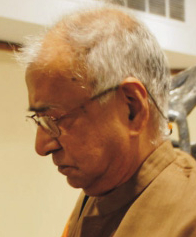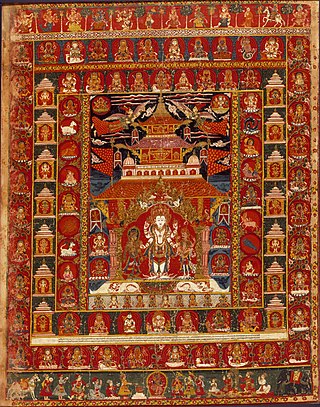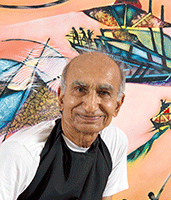
The Lalit Kala Akademi or National Academy of Art (LKA) is India's national academy of fine arts. It is an autonomous organisation, established in New Delhi in 1954 by Government of India to promote and propagate understanding of Indian art, in and outside the country.
Lain Singh Bangdel / Lain Bangdel (Rai), was Nepal's foremost artist, novelist, and art historian. In addition to being a leading authority on Nepalese art, Bangdel is best known as the "father of modern art" and was responsible for introducing the modern trends of Western art into Nepal with his pioneering one-man exhibition in Kathmandu in 1962.
Prayag Jha Chillar, also known as Prayag Jha, is a contemporary Indian artist, who specialized in etching. Her works are kept in collections all over India, including the National Gallery of Modern Art in the capital, Delhi. Jha's work was showcased in solo exhibitions from 1971 to 2012 across Jehangir Art Gallery, Taj Art Gallery, Bajaj Art Gallery, and Art Heritage New Delhi. Her work depicts scenes from the ancient Indian epic Meghdoot and is inspired by natural forms, such as grass and leaves. Jha's earlier works were primarily monochrome, but have evolved to include strong colors.
Sankho Chaudhuri was an Indian sculptor, and a noted figure in the art scene of India. (Although named Naranarain in due family tradition, he was more widely known by his pet name Sankho). Ram Kinker Baij was his teacher. He began close to cubism and then was influenced by István Beöthy, whom he had met in Paris. His themes have included the female figure and wildlife. He has worked in a wide range of media and produced large-scale reliefs and mobiles.
Kalidas Shrestha was a Nepalese artist, sculptor, social activist, and was the founding chairman of Kamala Memorial Community Service Center. He also founded Nepal Fine Arts College and was its first campus chief. He also served as an honorable member of Nepal Academy.

Kalpathi Ganpathi "K.G." Subramanyan was an Indian artist. He was awarded the Padma Vibhushan in 2012.

Jayanth Manda is a contemporary Indian artist.
Bhabesh Chandra Sanyal commonly known as B. C. Sanyal, the doyen of modernism in Indian art, was an Indian painter and sculptor and an art teacher to three generations of artists. During his lifetime he not just saw the partition of the Indian subcontinent three times, 1905, 1947 and 1971, but also witnessed 20th century Indian art in all its phases. His notable paintings include The flying scarecrow, Cow herd, Despair and Way to peace, which depicts Mahatma Gandhi with a Hindu and a Muslim child.

Nepalese Painting or Nepali Painting begins with the religious paintings with Hindu and Buddhist subjects, almost all Newa art by the Newari people of the Kathmandu valley. These traditional paintings can be found in the form of either wall paintings, cloth paintings called paubha, or manuscripts. They used conservative technique, style, and iconography in their works for centuries.
S. Chandrasekaran is a Singaporean contemporary artist known for his pioneering work in performance art in 1980s Singapore. He has held executive positions as Head of School at the Nanyang Academy of Fine Arts and LASALLE College of Arts.

Balan Nambiar is an Indian painter, sculptor, enamellist, photographer and an academic researcher.

Satya Mohan Joshi was a Nepalese writer and scholar. Joshi is known for his research on the history and culture of Nepal. He also served as the chancellor of the Nepal Bhasa Academy.
Manu Parekh is an Indian painter, known for his several paintings on the city of Varanasi. Reported to be influenced by Rabindranath Tagore and Ram Kinker Baij, Parekh is a recipient of the 1982 Lalit Kala Akademi Award. The Government of India awarded him the fourth highest civilian award of the Padma Shri, in 1991.
Thakur Prasad Mainali is a Nepalese artist and sculptor, known as a pioneer of Nepali modern art. He previously served as the chief of arts and craft department of the Royal Nepal Academy and served as Vice-Chancellor of Nepal Academy of Fine Arts. He is married to Indira Mainali and has five children, Lata Kaini, Laya Mainali, Meena Upreti, Rachana Rimal and Reecha Rijal.

Jayant Parikh is an Indian modern contemporary artist, printmaker, and muralist. He is a student of N. S. Bendre, K. G. Subramanyan and Sankho Chaudhuri. He lives and works in Vadodara, India.
The Punjab Lalit Kala Akademi is Punjab's state academy of fine arts. It's an autonomous cultural organisation established and funded by the Government of Punjab to preserve and publicize the fine art and culture outside the state. Punjab Lalit Kala Akademi uplifts the study and research in field of paintings, sculptures, mixed-media art and photography.

Pramila Giri is a visual artist who has been living and practising in Norway since 1997. She practises in the mediums of sculpture and painting. During the initial years of her practice in the 1980s, Giri experimented with marble and resin, mediums that had not as yet been used in Nepal in the arts. Presently her work synthesises large-scale abstract sculptures with paintings that create an environment, and have a monumental effect on onlookers. Her sculptures are installed in significant sites in Nepal and abroad. In 1978, she was among a group of artists who represented Nepal in the Fourth Triennale - India. In 2019, she participated in "Nepal Art Now," a large-scale exhibition at Weltmuseum Wien, "the most extensive exhibition of modern and contemporary art from Nepal to date" according to the museum's press release.
Shankar Nath Rimal is a Nepalese civil engineer and architect. He is best known for standardising the modern Nepalese flag. He has also designed many prominent buildings and monuments in Nepal. Sahid gate of Sundhara, Ramananda gate of Janakpur, Bhaleshwar temple of Chandragiri hill and Solatee hotel are some of the prominent structure he has designed.
Kiran Manandhar is a Nepalese artist, who was the founding chancellor of Nepal Academy of Fine Arts from 2010 to 2014. He is considered one of the pioneering Nepalese abstract expressionist painters.
Jagman Gurung is a historian, author and lecturer on Nepali culture.He was born in Yangjakot of Madi Rural Municipality, Kaski in Nepal. He is receipent of various national awards for his works related to culture and history of Nepal including Nepal Rishi Award and Rastriya Prathiva Puraskar.









